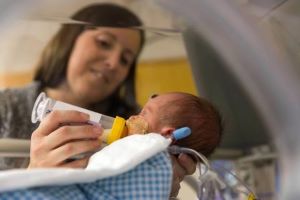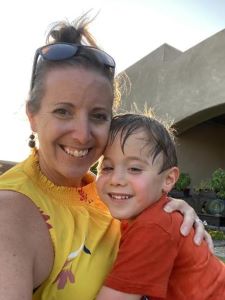A Premature Newborn, a Congenital Heart Defect and a New Way to Provide Mother’s Milk

For first-time mother Jackie, breastfeeding plans took a turn when her son Michael was born six weeks prematurely. After her son was diagnosed with a congenital heart defect in the neonatal intensive care unit (NICU) at Phoenix Children’s, she was unable to breastfeed him directly after doctors put him on a feeding tube. He was given breastmilk through the tube.
Instead of the quiet, bonding moments she envisioned with her baby at the breast, Jackie pumped breastmilk every two hours to give her newborn preemie the best start to life.
“Nobody expects to land in the NICU, so my idea of the day of giving birth and all the days after that were much different than what I had imagined,” Jackie said. “From my research, I knew that babies get prime nutrition from their mother’s breastmilk. In the end, it didn't really matter how he was getting the breastmilk, so the issue of breastfeeding versus pumping wasn't a big deal. I knew that if I had the ability to do so, I wanted to give him what was best, and breastmilk is tailor-made from the mom for the baby.”
An Early Delivery
During a routine prenatal checkup six weeks before Michael’s due date, Jackie was diagnosed with preeclampsia. This dangerous complication of pregnancy includes symptoms such as high blood pressure, elevated protein levels in the urine, headaches and blurred vision. Jackie’s OB/GYN sent her immediately to the local hospital in Yuma, where the family lives. She underwent an emergency cesarean section (C-section).
As Michael, weighing just 3 pounds, 9 ounces, was being cared for in the Yuma NICU, the medical team became concerned about gastrointestinal problems because he wasn’t passing meconium, a newborn’s first stool. They had him air evacuated to Phoenix Children’s, which could better provide him with the specialized care needed.
Caring for a Heart Defect
After thoroughly examining the newborn, doctors at Phoenix Children’s found nothing wrong with his digestive system. However, Michael was diagnosed with a coarctation of the aorta – a narrowing of the artery that goes out from the heart. The baby would need surgery, but it would not be safe to do so until he weighed about 5 pounds.
While the medical team monitored Michael’s growth, he was put on a feeding tube to measure his nutritional intake. Additionally, he was on a respirator for a couple of days to support his breathing.
Direct breastfeeding was not an option, so Jackie used a hospital-grade breast pump to express milk.
“We were able to put the breast milk through the feeding tube, along with other nutritional substances,” Jackie said. “I was pumping around the clock and bringing my milk into the hospital so that he always had enough.”
New Feeding Protocol in the NICU
The Phoenix Children’s Division of Neonatology put in place new guidelines for feeding babies in the NICU.
Neonatologist Navin Bhopal, MD, who leads the division’s feeding and nutrition work group, said the new protocols are aimed at reducing infections and the amount of time that newborns receive nutrition intravenously or through a feeding tube. The guidelines prioritize using the mother’s milk, or donor milk if the mother is unable to provide breastmilk.
The effort is having an impact: In 2021, 45% of Phoenix Children’s NICU babies were given breastmilk as part of their nutrition, compared to 40% the year before. Additionally, the rate of necrotizing enterocolitis – a life-threatening bowel disease – among NICU patients was cut in half, from 4.9% in 2020 to 2.5% in 2021. While other factors may have contributed to these positive results, breastmilk certainly played a role.
“Breastmilk has long-term health impacts in reducing infections and allergies, decreasing obesity and diabetes,” said Dr. Bhopal. “There also are possible benefits in terms of developmental impact, although that's not one hundred percent proven. But with regards to our most fragile babies, every little thing that happens to them during the NICU stay impacts their long-term developmental outcomes. If they develop infections in the NICU, that decreases their chances of survival. And if they do survive these problems, they may have a higher risk for developmental problems in the future. So, feeding them human milk can improve their survival and development. We want to make sure that each baby has a long, healthy life with their family.”
Adjusting to Life with a Newborn in the NICU
Was Jackie disappointed that her breastfeeding plans had to change?
“During that time period, we were in survival mode,” Jackie said. “More than anything else, we were just trying to keep up with the day-to-day. I honestly didn’t have time to really absorb how Michael’s condition changed my plans to breastfeed. I go with the flow pretty easily, so once I realized direct breastfeeding wouldn’t happen, I was ready to just feed him another way.”
Jackie did face some challenges. Because the baby wasn’t suckling directly from the breast, her milk came in slowly. As she was learning the best techniques for pumping breastmilk, she dealt with the stress of worrying about her baby’s health, as well as her own physical healing from the C-section. And the family’s home in Yuma was a three-hour drive from Phoenix. Fortunately, Jackie and her husband Kurt had family living in Phoenix, so they had a place to stay when they weren’t at Michael’s bedside.
Once Michael was big enough, the cardiovascular team at Phoenix Children’s was able to do the surgery to repair his heart defect. He stayed in the cardiovascular ICU (CVICU) for about a week and then returned to the NICU. Doctors wanted him to grow a little more before making the long drive back home.
After about six weeks in the NICU – on Michael’s due date – the family was able to return home.
Triumph over Medical Challenges

Now 4 years old, Michael has undergone five additional surgeries at Phoenix Children’s for developmental concerns, including craniosynostosis – a birth defect in which the skull bones fuse together too early – a tethered spinal cord and two hernias. While he now sees a pediatric cardiologist closer to home, the family still makes regular visits to Phoenix Children’s, where Michael’s neurosurgeon and plastic surgeon continue monitoring his skull plate and spinal cord.
Despite the medical challenges he’s faced, Jackie described Michael as “an energetic preschooler doing everything you would expect.”
While many of his milestones have come later than the average expectations, he has made steady progress. Take walking for example, “There was no phase of toddling and falling down – one day he was crawling, and the next thing we knew, he was running. He’s just a happy, healthy boy.”
Jackie and Kurt are grateful to the team at Phoenix Children’s for getting Michael through a rough start to life.
“The doctors, nurses and the medical staff are amazing at Phoenix Children’s,” Jackie said. “We had confidence that if we left the hospital to rest, they would call us if we really needed to be there for Michael. We are grateful for everything they did for our family.”
